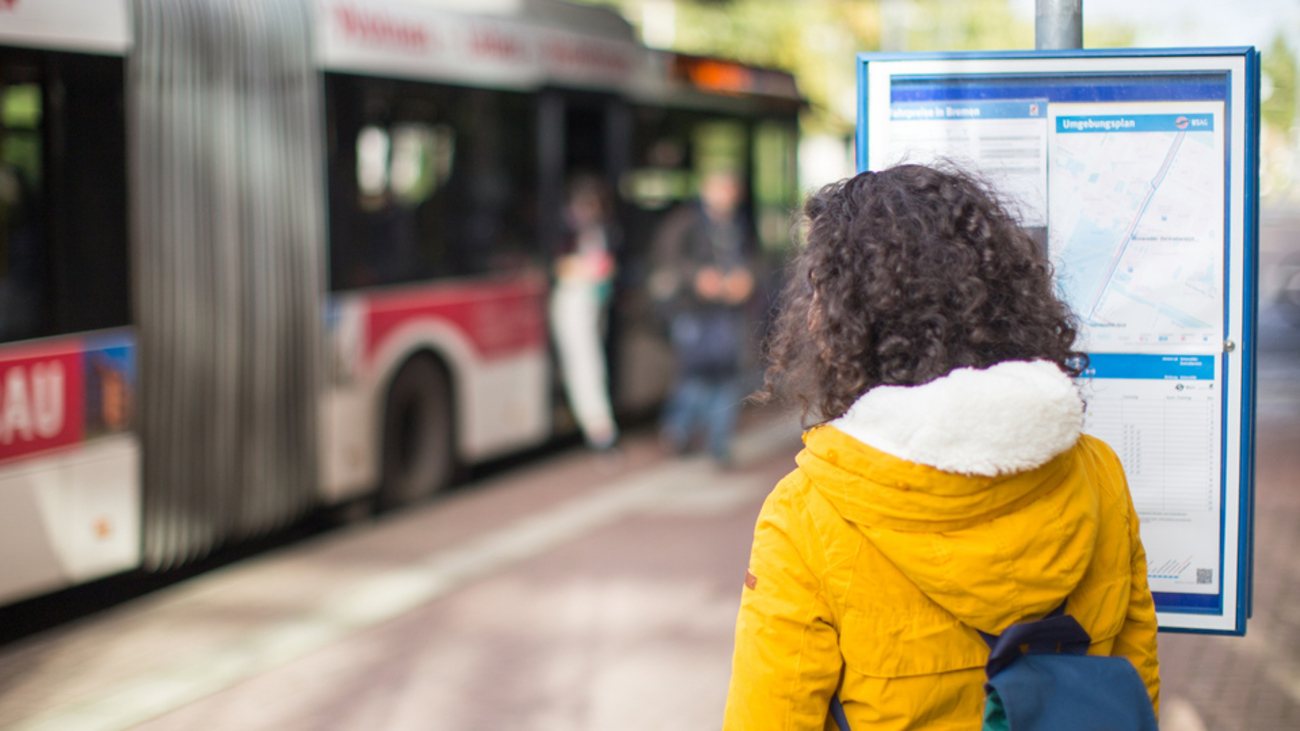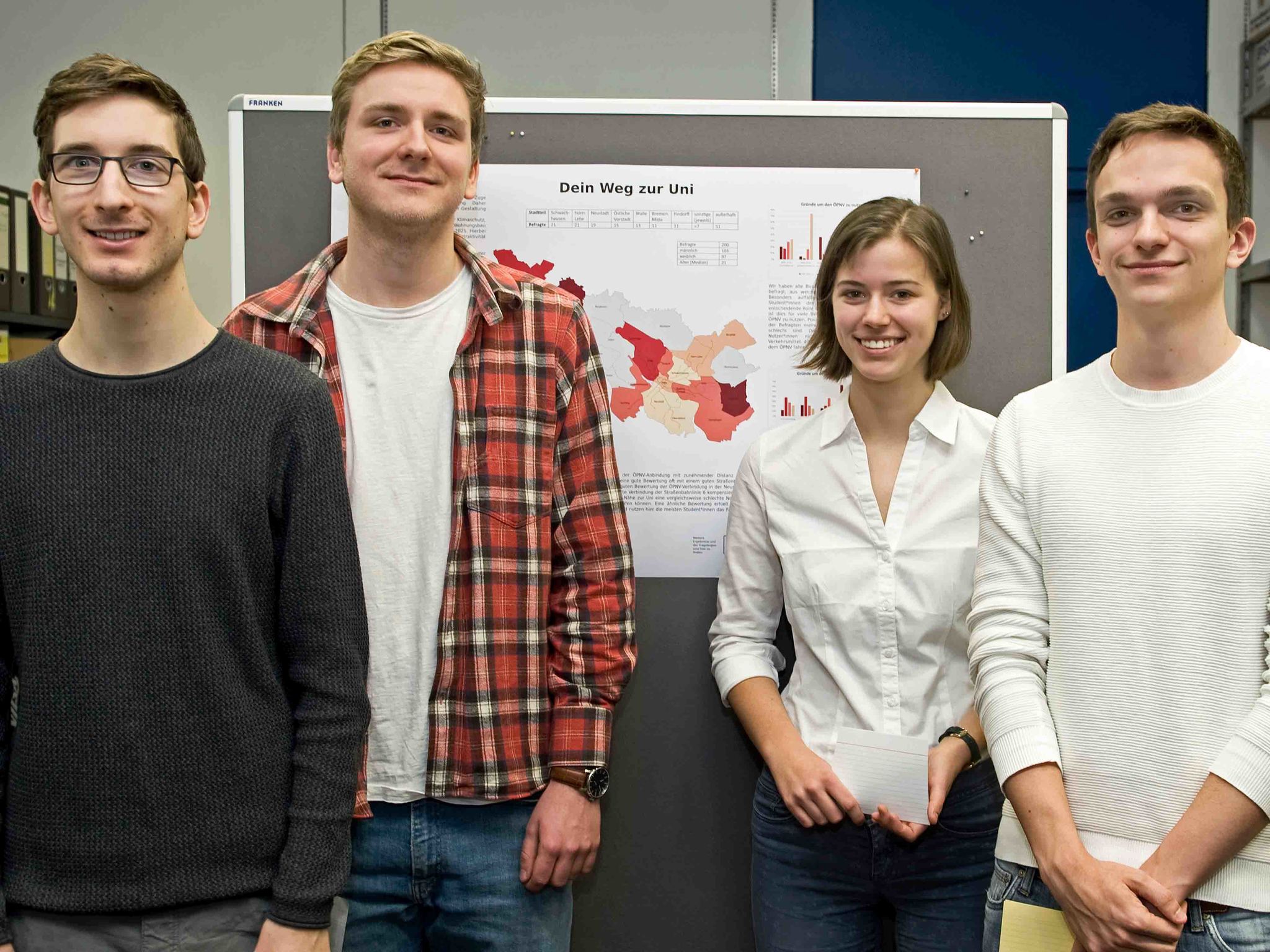
Photo: Matej Meza / University of Bremen
How Do You Get to University?
How do students travel to university?
By bike or by car? Or do most students use public transport? That was the topic of the survey “Your Way to Uni”. 200 students participated. One first result: the semester ticket and the tramline 6 are the undisputed champions.
In geography, there is the now award-winning module “Introductory Project”. Here, students commence their own research in small groups as early as the first bachelor semester. They choose their own topics, conduct their research, study sources, and create appealing posters to illustrate their results. The final step is the presentation to the university public.
This is something Clara Gübel, Finn Irmer, Jan Ismer, and Sebastian Kaienburg have managed masterfully with their self-chosen topic. “Student transport mobility,” said Finn Irmer in his introductory remarks, “of course includes the dimension of climate change.” The young geographers, therefore, began their research with studying the senate’s transport development plan for the city of Bremen. By 2025, bus, tram, and bicycle are supposed to be real alternatives to taking the car.

Photo credit: Harald Rehling / University of Bremen
It Can Get a Little Crowded on the Tram
As expected, during the summer semester, one third of students travel to the campus by bike, 55 percent choose bus and tram, ten percent get into their car. In winter, public transport is the most inviting: almost 70 percent are using it and only 14 percent pedal in all weathers. Respondents frequently criticize: trams are often getting crowded then. Jan Ismer pointed out that it was important to the young researchers to separate the overall figures according to city districts, namely those with the highest student density. 80 percent of those surveyed living in the surrounding area of Bremen use public transport to get to the university. 70 percent of students from Neustadt come by public transport. Tram line 6 is the undisputed star here! In Horn-Lehe and the eastern suburbs, students prefer to use the bicycle to get to university. Sebastian Kaienburg explains the average ratings of public transport connections on a scale of 1 to 6: Neustadt, Schwachhausen, and Obervieland perfom best with 1.6, while Vegesack and Osterholz are the bottom of the list with 3.7. “Nevertheless, overall these are very positive results,” says Kaienburg.
Affordable Tickets for All
“The affordable semester ticket is the reason many students take public transportation to university,” Clara Gübel concludes the survey. Overall, the group believes that Bremen’s citizens should receive similarly inexpensive tickets if the goal of a car-free city center by 2030 is to be achieved. In the end, lecturer Daniel Schuster asks if there were any surprising results. “Most of the cyclists come from the Faculty of Social Sciences and most of the motorists from the Faculty of Law,” says someone from the group promptly and raises a laugh.
About the Introductory Project
Students of geography at the University of Bremen begin their studies from the start with independent research. Their lecturers and tutors closely accompany them in their research-based learning. “In the introductory project, we don’t just present the results to the students and expect them to learn afterwards, but we encourage them to work independently,” says Professor Ivo Mossig, who received the innovative teaching award from the Association for Geography at German-speaking Universities and Research Institutions in 2019 for this project.
During the presentation, student groups elaborated other highly demanding topics: potential conflicts for Bremen’s flood control methods, the relevance of seawater desalination in Northern Germany, nitrate analyses of Bremen’s groundwater, salinity development of the Weser and its effects on the ecosystem, sustainability certification in the hotel and restaurant industry using the example of Langeoog, the potential of the Waterfront development, the question of whether Bremen can cope with rising sea levels, and the effects of European soy consumption on Brazilian agriculture. The range of subjects is astonishingly broad.